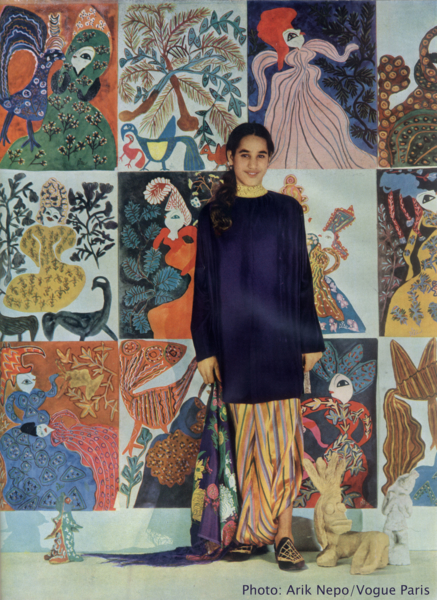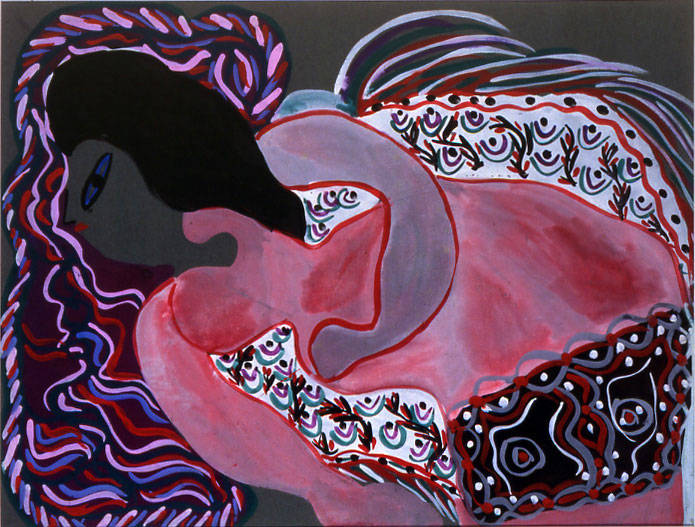We use Cookies. Read our Terms
- News
- The wondrous world of Baya
The wondrous world of Baya

Femmes Attablees, 1947
Algerian artist Baya Mahieddine (1931 - 1998) repeatedly rejected attempts to label her style – naive, primitive, surreal, oriental, outsider – preferring to let her fantastically flamboyant images of female figures, flora and fauna speak for themselves.
Though celebrated in Algeria, France and the Middle East, Baya (as she chose to be known) has yet to gain greater international recognition. Perhaps her background or initial association with mid-century luminaries such as Pablo Picasso, Andre Breton and Jean DuBuffet discouraged broader or more dedicated consideration of her work.
A new exhibition redresses this oversight. Baya: Woman of Algiers – on view at New York University’s Grey Art Gallery, January through March – is the first solo show of Baya’s art in North America. Comprising 22 gouache paintings from her 1947 Paris debut, it was curated by the French American scholar Natasha Boas, who recasts Baya’s legacy within critical, contemporary, feminist
Largely self-taught, Baya is not an artist whose intentions are readily apparent. Her brilliant colors, boldly-patterned shapes and fluid lines reflect her own complex cultural inheritance – Kabyle, Arab, Islamic and French. The idyllic, fertile, feminine scenes she paints are expressive and imaginative but nonetheless circumscribed. Men are nowhere to be seen; possibly even excluded from Baya’s world.

Baya, aged 16, at the time of her Paris debut.
Big, open eyes are a recurring focal point. Earlier critics, such as the late Algerian novelist Assia Djebar, have described this female eye of Baya’s as a ‘liberated’ one. It can be read as a reversal of the male gaze – a prominent theme in Western figurative art – as well as a subversion of traditional Islamic art, which rarely depicts the human figure. Resembling the Arabic letter for ‘H’, Baya’s eye can also be identified as the Egyptian Horus or hamsa eye, worn as a good luck charm throughout the Arab world.
“Baya’s unclear delineations, indeterminate locales, closed spaces, and floating objects lacking perspective or volume invite us to think more broadly about borders and boundaries: Where does the natural female body begin and end before it becomes cultural?” asks Boas.
In looking back on modernist art history from today’s vantage point, Boas concludes that the most significant function in Baya’s work may be her step into the visible. “Removing the veil of invisibility, Baya upholds the right to see and the knowledge that seeing means being visible,” writes Boas. “Being exposed to being seen is what Baya’s women do.”
Baya’s works can still be seen in the collections of the National Museum of Fine Arts in Algiers; the Arab World Institute in Paris; the Picasso Museum in Antibes; the Collection of Art Brut in Lausanne, and the Barjeel Art Foundation in Sharjah.

Femme Allongee Au Visage Bleu, 1947
Baya’s biographical dates (thanks to research compiled by curator Natasha Boas)
- 1931: Baya is born (Fatma Haddad) to a poor Kabyle-Arab family in Bordj el-Kiffan (then named Fort de l’Eau), a seaside suburb of Algiers.
- 1936 – 1941: Orphaned at the age of five, Baya is sent to live with her grandmother. She does not attend school. Her aptitude for drawing and sculpting attracts the attention of her grandmother’s employer, the French intellectual Marguerite Camina Benhoura.
- 1942 – 1945: Baya is officially adopted by Benhoura, who provides her with art supplies, instruction, and access to her circle of French and Maghrebi artists, as well as to her personal collection of modernist masterpieces.
- 1945 – 1947: Baya’s work is seen by the French art dealer Aime Maeght. He shares his enthusiasm with Andre Breton, who includes one of Baya’s gouaches in his July 1947 exhibition of international Surrealist art at Galerie Maeght in Paris.
- November 1947: Galerie Maeght hosts a solo exhibition of Baya’s gouaches and ceramics. The 16 year-old’s work attracts Paris’ avant-garde intellectual elite, as well as a popular audience. Baya is featured in the February 1948 issue of French Vogue.
- 1948 – 1952: Baya (still in Benhoura’s care) is invited to become artist-in-residence at the Madoura ceramic studio in the south of France, where she spends her summers working alongside Pablo Picasso. Picasso later cites her as one of the inspirations for his Women of Algiers series.
- 1953 – 1962: Baya returns to Blida, Algeria to become the second wife of El Hadj Mahfound Mahieddine, a traditional Muslim and acclaimed ‘arabo-andalusian’ musician 30 years her senior. She bears and raises six children. She abandons painting during this period, which roughly coincides with Algeria’s eight year war of independence.
- 1963: Baya starts painting again. She’s encouraged by the newly appointed director of the Museum of Fine Arts in Algiers, Jean de Maisonseul, who repatriates some of her work from France and organizes a retrospective of her gouaches.
- 1964 – 1998: Baya continuously paints and exhibits – in Algeria as well as abroad – nearly every year until her death.